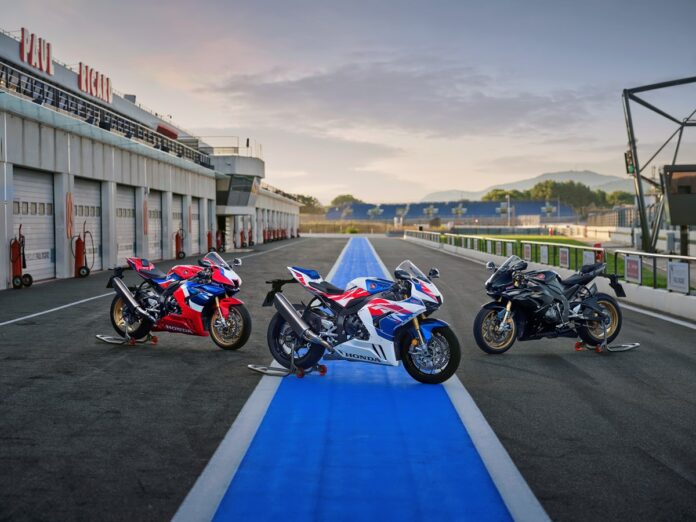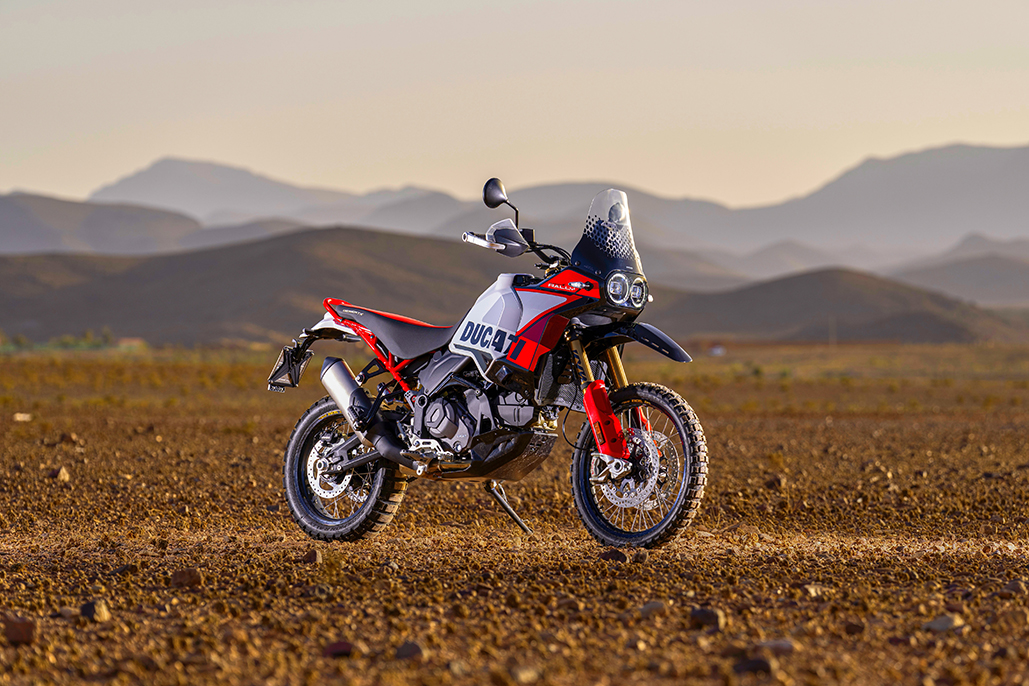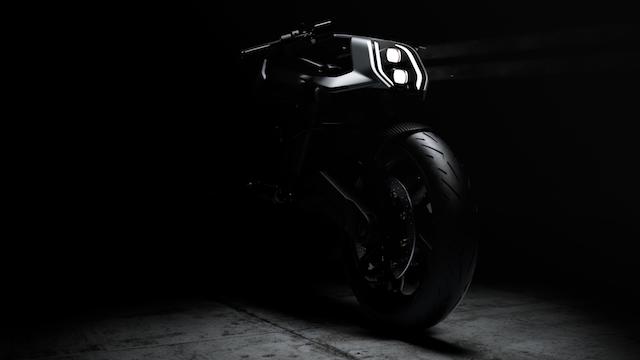2022 Honda CBR1000RR-R Fireblade
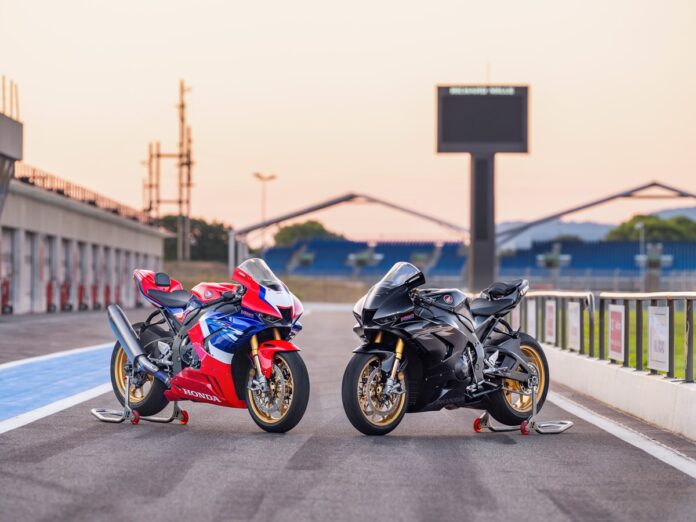
Model updates: The CBR1000RR-R Fireblade heads into its 30th year of production. For its 20YM iteration it was a brand new machine from the ground up, created with an unwavering focus on circuit riding. Now, for 22YM development of its 160kW @ 14,500rpm, inline four-cylinder engine has centred on mid-corner acceleration and drive: intake ports, airbox, airbox funnels and exhaust mid-section have all been revised to deliver extra mid-range. The final drive sprocket goes up 3 teeth, to 43, for stronger acceleration through each ratio. Honda Selectable Torque Control (HSTC) has also been optimised – with feedback from HRC’s riders – for refined rear tyre traction management, and throttle feel improved even further. A new material and surface finish for the front Nissin brake calipers’ pistons improves braking performance and consistency in race conditions. The rest of the chassis – comprising aluminium diamond-style frame, RC213V-S-style swingarm, six-axis Inertial Measurement Unit (IMU), 3-level Honda Electronic Steering Damper (HESD) and Showa suspension front and rear – is unchanged. The bodywork and riding position maintain an uncompromising focus on aerodynamic performance, and the fairing features MotoGP-derived winglets to generate downforce. A full-colour TFT screen offers intuitive control of riding modes and adjustment of Power, Engine Brake, HSTC, Wheelie Control, Start Mode and ABS modes. A Smart Key is the finishing touch.
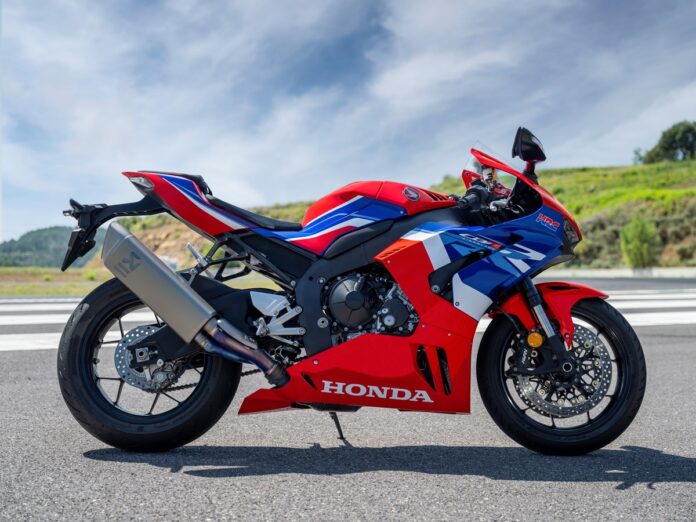
22YM HONDA CBR1000RR-R FIREBLADE
- Introduction
Since its original 1992 introduction Honda’s iconic Fireblade has evolved into an incredible 1000cc sports motorcycle. And it’s also been the base of a competitive race machine, on short circuits around the world and the roads of the Isle of Man TT.
But time – and competition – always races on and in 20YM Honda drew the line under where the CBR1000RR Fireblade had been, and looked forward to where it was going. And, as a result, two brand-new motorcycles – the CBR1000RR-R Fireblade and CBR1000RR-R Fireblade SP* – were created with heavy involvement from Honda Racing Corporation to carry the legend forward.
Leaning heavily on the engine and chassis technology of the RC213V-S ‘street-legal MotoGP machine’, with aerodynamics drawn from the RC213V MotoGP bike, the new Fireblade was designed from the ground up – in terms of engine, handling and aerodynamics – for pure, outright track performance.
2022 is an important anniversary for Honda, and its Fireblade, as it marks 30 years of what has proved, over time, a seminal sports machine. A variety of detail updates improve both corner-exit acceleration, HSTC control and braking and, to mark three decades of undiluted performance, the CBR1000RR-R Fireblade SP 30th Anniversary* will be available in a limited edition, instantly-recognisable and evocative paint option that plays homage to the original 1992 style design.
*See separate CBR1000RR-R Fireblade SP release for full information.
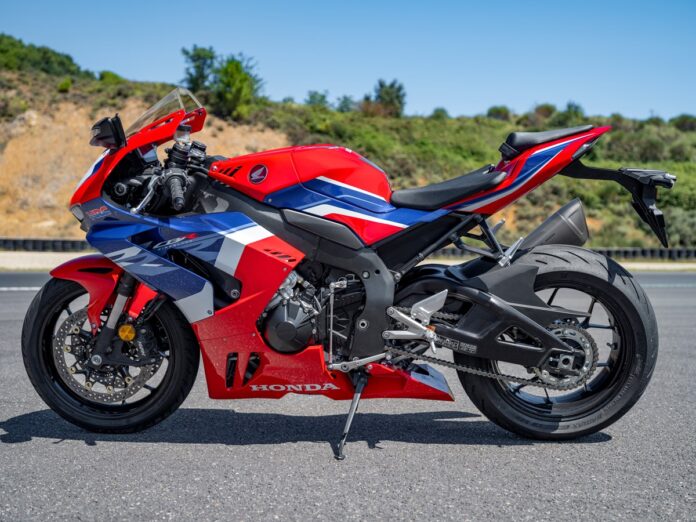
22YM HONDA CBR1000RR-R FIREBLADE
- Model Overview
The Fireblade’s inline four-cylinder engine delivers 112Nm @ 12,500rpm and makes peak power of 160Kw @ 14,500rpm.
Updates for 22YM centre around upping mid-corner drive and acceleration. Firstly, the rear sprocket goes from 40 to 43 teeth, improving acceleration through the gears in the mid-range while maintaining high-rpm output.
Both airbox and intake funnels have been re-shaped to smooth flow. The intake ports have been adjusted to increase airflow velocity while exhaust flow into the catalyser (and the catalyser itself) has also been optimised.
Throttle By Wire (TBW) spring load has been reduced, for improved linearity and response on opening. Using extensive feedback from racers around the world – including Honda’s HRC World SBK team – Honda Selectable Torque Control (HSTC) has been refined to offer the rider the power, grip level and feel they want, and to match the increased drive.
As before, three default riding modes cover most conditions with options to fully adjust Power, Engine Brake, Wheelie Control and HSTC. The electronics package also includes adjustable Start Mode.
The engine uses a compact, short-stroke layout – sharing the bore and stroke of the RC213V – and features a semi-cam gear train, finger-follower rocker arms, titanium con-rods, RC213V-S internal friction reduction technologies, piston jets with check ball system and a built-in bottom bypass passage for the cylinder water jacket. A ram-air duct in the front fairing feeds directly through the headstock. The 4-2-1 exhaust downpipes are ovalized and the end-can was developed in conjunction with Akrapovič.
An aluminium diamond frame uses the rear of the engine as the upper shock mount while the swingarm is based on the RC213V-S design. The rigidity balance, weight distribution and steering geometry are carefully adjusted to exploit the engine’s output, in terms of front and rear grip levels, and feel for both. A six-axis Inertial Measurement Unit (IMU) provides accurate 3D estimation of riding dynamics and provides input to manage all of the electronic systems. It also controls the rod-type 3-level Honda Electronic Steering Damper (HESD).
Showa’s 43mm Big Piston Fork (BPF) is matched to a Showa Balance Free Rear Cushion Lite (BFRC-L). The front discs are worked by Nissin four-piston calipers, which have received revised piston material and surface treatment improving heat management. The ABS is adjustable for track riding.
Honda’s RC213V MotoGP machine has leant some of its slippery aerodynamics to the Fireblade, including winglets to increase downforce and improve braking stability. The riding position is also very compact. A fully customisable 5-inch TFT display offers intuitive control via a four-way switch on the left handlebar. Honda’s Smart Key system adds convenience
The CBR1000RR-R Fireblade will be available in the beautiful Grand Prix Red colour scheme introduced for the 20YM redesign, now featuring a white front ‘number board’.
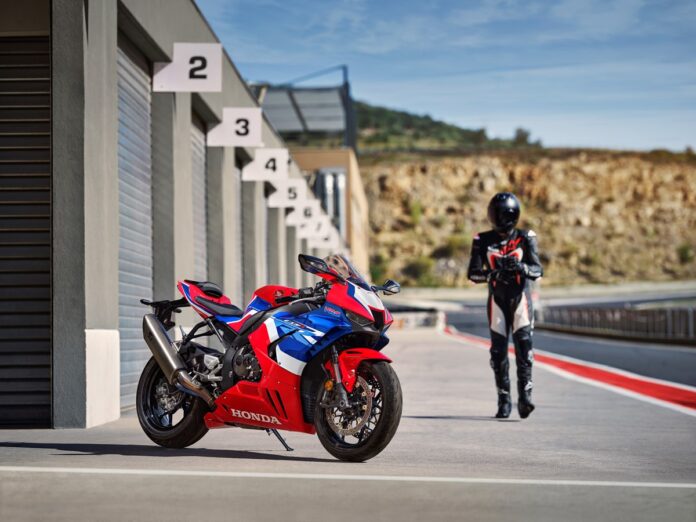
22YM HONDA CBR1000RR-R FIREBLADE
- Key Features
3.1 Engine
- Short-stroke, inline four-cylinder engine produces high output at high rpm; 160Kw @ 14,500rpm with peak torque of 112Nm @ 12,500rpm
- New 43 tooth rear sprocket shortens overall gearing for improved drive and acceleration, opening up gear selection choice
- Intake ports re-shaped to increase flow; air intake funnels and airbox revised to match
- 4-2-1 exhaust ‘2’ mid-section and catalyser optimised for gas flow
The Fireblade’s 1000cc, inline four-cylinder semi-cam gear engine was designed with heavy input from the HRC MotoGP development program. It generates peak power of 160Kw @ 14,500rpm, with peak torque of 112Nm @ 12,500rpm. To achieve the required valve size, combustion efficiency and friction reduction to generate these numbers, the Fireblade’s engine shares the same ‘over square’ 81mm bore and 48.5mm stroke as the RC213V. Compression ratio has increased from 13.2:1 to 13.4:1.
Air is fed into the engine via a ram-air duct located at the high-surface pressure tip of the front fairing; the size of its aperture is equivalent to that of the RC213V MotoGP machine. A ribbed ‘turbulator’ to the right, left and above the duct entrance ensures maximum induction of moving air with minimal impact on handling. The draft angle of the aperture’s interior wall maintains flow under high-speed and acceleration.
To maintain stable performance across a wide speed range, pressurised air takes a straight shot through the headstock, around the steering stem and into the airbox. This smooth path is made possible by Honda’s Smart Key system and steering angle of 25°. To draw the volume of air needed, the throttle bodies employ 52mm diameters.
New for 22YM, for smoother airflow on an opening throttle, the ‘dirty’ side of the air filter has been adjusted to control the direction of intake air separation and vortex generation. On the ‘clean’ side, filtered air now feeds slash-cut intake funnels, with #2 and #3 shortened by 15mm. Also, and to match, the inner diameter of the intake ports has been partially narrowed to increase airflow velocity, improving filling efficiency thus performance through the mid-range. Supplementing this change, with the same aim of improved acceleration through the gears in the mid-range, while maintaining high-rpm output, the rear sprocket goes from 40 to 43 teeth.
Mirroring the intake side, the four exhaust downpipes use an oval cross section. For 22YM, the 4-2-1 exhaust now features a redesigned ‘2’ section, feeding the catalyser (and the catalyser itself), for optimised gas flow.
Constructed from titanium, the Akrapovič-design muffler’s small physical size and light weight contribute to mass centralisation and right-side lean angle. The exhaust valve was also designed with Akrapovič to deliver both low-rpm torque and high-rpm power; a valve stopper (patent-pending) stops exhaust-gas leak when closed while also reducing noise.
The inlet valves are 32.5mm diameter, with 28.5mm exhaust; they’re operated by finger-follower rocker arms; valve angle on the intake side is 9°, reducing the surface area of the combustion chamber and improving combustion efficiency.
MotoGP technology is everywhere internally. Friction is reduced by the use of Diamond Like Carbon (DLC) on the cam lobes – just like the RC213V-S. 20YM marked the first time this process was used on a mass-produced motorcycle and allows a reduction in valve train frictional loss of 35% compared to non DLC-coated lobes.
The valve train is driven by a semi-cam gear train system. To drive such high-rpm/high-cam lift performance the chain is driven from the timing gear located on the crank shaft via the cam idle gear; this makes it shorter in length.
Forged, lightweight TI-64A Titanium (a material developed by Honda) con-rods and con-rod caps save 50% in weight compared to Chromium Molybdenum steel versions; they also employ HB 149 Chromium Molybdenum Vanadium (Cr-Mo-V, again a Honda development) steel bolts and do without fastening nuts.
To ensure durability the same configuration as the RC213V-S is applied to the sliding surfaces; the small-end bushings are made of shaved C1720-HT Beryllium copper (because of its high-rpm reliability) while the surfaces of the big-ends are treated with DLC.
The pistons are forged from A2618 aluminium (like the RC213V-S) for lightweight strength and durability. To guarantee high-rpm wear resistance the piston skirts feature an Ober coating (Teflon and Molybdenum base) and nickel-phosphorous plating for the piston-pin clip-groove.
To manage temperature the pistons use a multi-point piston jet which sprays cooling oil in multiple directions through each cycle. At low rpm – when not needed – check balls within the jets shut off the flow of oil in order to limit oil pressure loss and reduce friction.
To reduce bore distortion (and thus friction), the cylinder features a built-in bottom bypass. This system circulates cool water from the radiator into the main water jacket, while the area below uses non-cooled water. The net effect is a lower, and more even, temperature at all points across the bores.
Minimising width, the engine is started by rotation of the clutch main shaft rather than the crankshaft. This design allows for a more compact crankshaft, while double use of the primary driven gear to also transmit rotation from the starter motor saves space; the engine is short in length, with a short distance between the crankshaft, counter shaft and main shafts. The rear of the engine block also serves as upper shock mount.
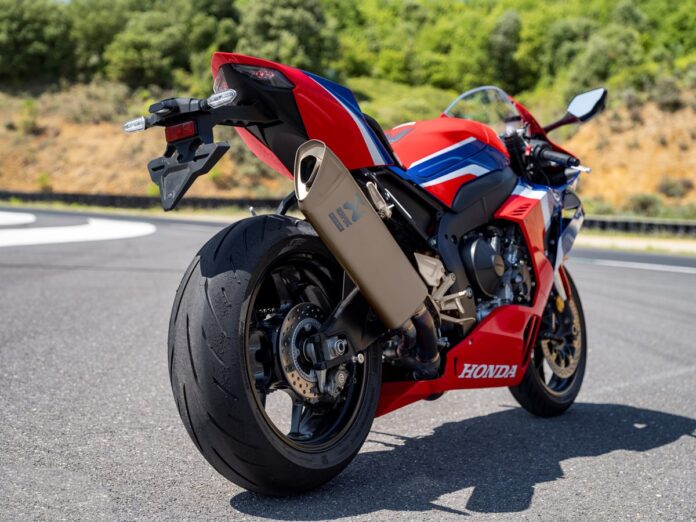
22YM HONDA CBR1000RR-R FIREBLADE
3.2 Engine Electronics
- Honda Selectable Torque Control (HSTC) software upgraded for smoother traction management, with feedback from HRC’s riders
- Throttle By Wire return spring load lightened for more linear throttle delivery
- Three default riding modes plus options to customise Power, Engine Brake HSTC and Wheelie control
- Start Mode standard fitment
The 17YM CBR1000RR was the first in-line four-cylinder engine from Honda to use Throttle by Wire (TBW). Derived and developed from the system used by the RC213V-S, it controls the throttle butterfly valve angle (relative to input from the throttle) to provide a linear delivery and puts precise throttle control – and a natural feel – in the rider’s right hand. It’s a critical area and for 22YM, to match the increased drive, the TBW return spring load has been reduced, further enhancing the response and linearity of throttle input.
In conjunction, the 9-level (plus off) Honda Selectable Torque Control (HSTC) has also been upgraded. For 20YM The CBR1000RR-R Fireblade HSTC gained slip rate control (which monitors the rate at which slip is changing based on the ratio of front/rear wheel speeds) to smoothly moderate rapid wheel spin. For 22YM the gap between the intervention timing and
slip rate has been changed for even smoother, intuitive grip management, with software developed with wide-ranging, top-level feedback from around the world, including HRC’s riders.
There are three default riding modes, with options to change engine output and character. Power (P) operates through levels 1-5 with 1 giving ultimate outright power. Engine Brake (EB) manages performance on a closed throttle through levels 1-3, with 1 being the strongest engine braking; Wheelie (W) manages through levels 1-3 (plus off) with 1 giving the weakest intervention.
Wheelie Control uses information gathered by the IMU on the Fireblade’s pitch angle, along with front and rear wheel speed sensors, to maintain torque and deal with the wheelie without sacrificing forward drive.
The Fireblade is also equipped with Start Mode for race starts. It limits engine rpm at 6,000, 7,000, 8,000 and 9,000rpm set-points, even with a wide-open throttle, letting the rider focus on clutch release (and lights) alone.
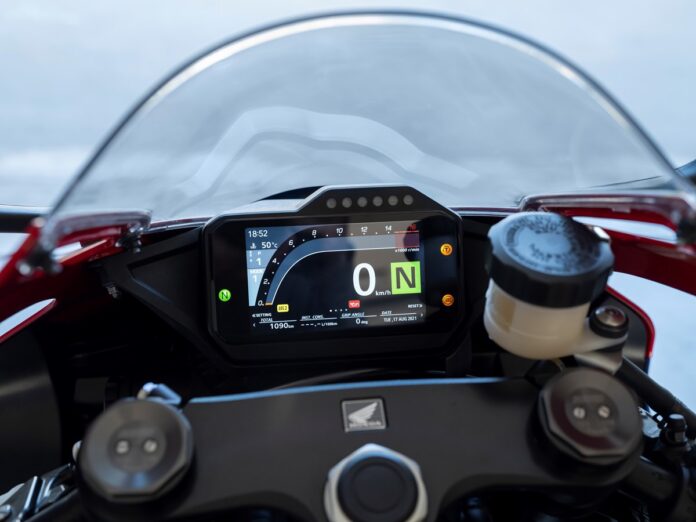
22YM HONDA CBR1000RR-R FIREBLADE
3.3 Chassis
- The Nissin radial-mount four-piston calipers employ a new piston material and surface treatment for more powerful, consistent braking in race conditions
- Aluminium frame and swingarm feature tuned rigidity balance for precise handling and feel for grip
- Bosch six-axis Inertial Measurement Unit (IMU) gives accurate calculation of dynamic behaviour and precise control
- Showa 43mm Big Piston Fork (BPF) and Balance Free Rear Cushion Light (BFRC-Lite) rear shock offer complete adjustability
- Showa’s 3-level Honda Electronic Steering Damper (HESD) controlled by IMU for stability management
The diamond-style main frame is constructed from 2mm aluminium with an extremely accurate tuning of the rigidity balance; in manufacture, after the four main frame components are welded, the engine mounts in six locations improving machine handling. Vertical and torsional rigidity are carefully balanced against each other, with the aim of producing maximum levels of feel.
Wheelbase increases 5mm to 1,460mm, with rake and trail of 24°/102mm. Wet weight is 201kg. Weight distribution is set at 53% / 47% front to rear, while a high c-of-g improves side-to-side agility.
The swingarm – stamped out from 18 individual thicknesses of aluminium and as used by the RC213V-S – is 622.7mm long. Like the main frame, its horizontal and vertical rigidity are tuned together to generate grip and feel.
For optimum frame rigidity (and to save weight) the top mount of the Pro-Link rear shock attaches to the rear of the engine block via a bracket. This also isolates the rear wheel from the headstock, improving high-speed stability and feel for rear wheel traction.
Round, thin-wall aluminium tubing forms the minimal subframe. It also mounts to the frame from the top to narrow the area around the rear of the fuel tank and seat, making for a compact – and aerodynamically efficient – riding position. Seat height is 830mm, with forward-set handlebars (for leverage) and raised, rear-set foot pegs.
A Bosch six-axis Inertial Measurement Unit (IMU) delivers accurate calculation of pitch and
roll for precise control of the bike’s behaviour. The Fireblade is also equipped with Showa’s Honda Electronic Steering Damper (HESD), a lightweight, through-rod design that mounts on the bottom of the steering stem and attaches to the bottom yoke. HESD is controlled by input from the wheel speed sensors and IMU; 3 levels of control are available.
With its large damping volume, the Showa 43mm Big Piston Fork (BPF) inverted telescopic forks effectively reduce hydraulic pressure generated under compression and extension. This results in reduced play during the initial stroke and smoother damping, maximising tyre contact with the tarmac. Spring preload and rebound/compression damping are fully adjustable and for the Fireblade the fork is slightly longer in length, allowing more freedom for geometry changes track-side.
The rear shock is a fully adjustable Showa Balance Free Rear Cushion Light (BFRC-Lite). Instead of a conventional single-tube layout, BFRC-Lite uses a double-tube design: the damper case and an internal cylinder. The damper piston has no valves – instead the damping force is generated as displaced oil passes through a separate damping component. This allows pressure changes within the shock to be smoothly controlled, damping response and reaction to be improved, and damping force to function smoothly during load input. Moreover, damping weight is generated consistently when switching from rebound to compression due to even pressure changes.
Delivering improved braking power and consistency – for the heavy load experienced in super stock racing classes – the Nissin four-piston radial mount front brake calipers utilise a new piston material and surface treatment to dissipate and manage heat, and maintain lever feel. They grip 330mm diameter/5mm thick discs. The rear brake caliper is the same Brembo unit used by the RC213V-S.
Rear lift control and ABS-managed brake force relative to lean angle boost confidence on turn-in. The system features two switchable set ups; SPORT mode focuses on road-riding performance, with high brake force and less pitching, while TRACK mode offers performance in braking from much higher circuit speeds.
The rear 17-inch rim mounts a 200/55-ZR17 sized tyre, minimising the change in chassis geometry when going from street to track rubber. The front rim mounts a 120/70-ZR17 tyre.
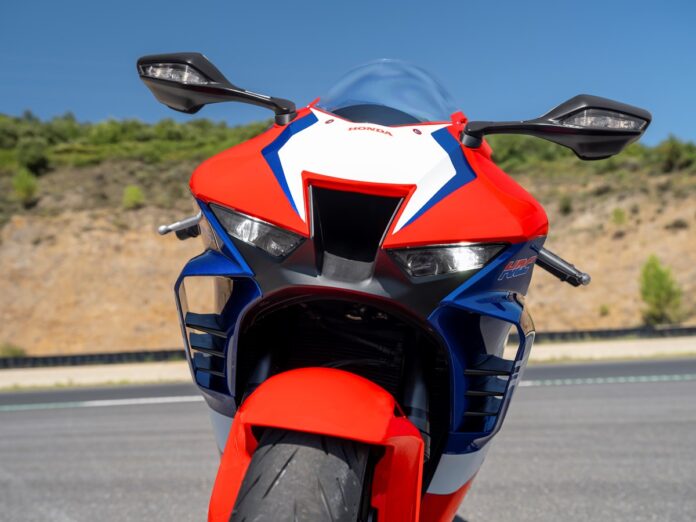
22YM HONDA CBR1000RR-R FIREBLADE
3.4 Aerodynamic Package & Equipment
- Fairing, screen and mudguard minimise frontal area and reduce drag; low fuel tank cover provides compact riding position
- Inner fairing winglets drawn from the RC213V MotoGP machine reduce wheelies under acceleration and improve braking stability
- 5-inch colour TFT screen and four-way left-hand switch offer intuitive control of riding systems
- Smart Key operation adds convenience
An aggressive fairing design is no mere styling exercise: it’s designed to create a class-leading drag coefficient (with a tucked-in rider under track conditions) and restrict lift under acceleration while improving braking stability.
The fuel tank cover is set low, decreasing the frontal area with the rider prone. At a 35° angle the screen smoothly channels airflow from the upper fairing over the rider and seat cowl, which itself presents the minimum possible drag resistance. The left and right upper fairing slits reduce yaw and roll resistance while turning.
To make steering easier, a convex surface on each side of the front mudguard moves air flow away from the front wheel, smoothly directing it to the fairing sides. Cooling air for radiator and oil cooler is optimised by aerodynamic management of both velocity and pressure of air flowing from the tyre.
The lower fairing extends close to the rear tyre, and is shaped to channel air downward. This has two effects: in dry conditions, less air hits the tyre, lowering drag; in the wet, less water hits the tyre, improving grip. To let air flow around the rider’s feet with minimum resistance the sides of the rear hugger are carefully shaped, while its upper side is cut-out to vent air that channels up from underneath either side of the swingarm, decreasing rear lift.
The net result, with the Fireblade in stock race trim, is a best-in-class drag coefficient value of 0.270.
To generate downforce at track speeds – and maintain the smallest possible frontal area – the fairing also employs winglet structures that effectively generate the same downforce as the 2018 RC213V MotoGP machine. The results are a reduction in wheelies under acceleration and increased stability on braking and corner entry.
Three wings are arranged in a vertical line inside both left and right fairing ducts. This arrangement (vertically deep and longitudinally shallow) has no detrimental effect on yaw and roll ability during corner entry. And the consistent distance between the trailing wing tips and the inner fairing wall limits separation of the airflow, producing maximum downforce.
The wing angle balances opposing right/left downforces from the dihedral and twist angles when yaw occurs through a corner, for stable behaviour. Flow speeds over the top and below the wings differ to prevent air getting ‘trapped’ on the fairing sides and affecting handling.
For full and intuitive control of the Fireblade’s systems there’s a high resolution, full colour 5-inch TFT screen. It’s fully customisable to show exactly what the rider wants to see. The compact left hand switchgear houses a four-way switch; fast and easy to use, the top/bottom buttons set riding mode parameters, while the left/right buttons cycle screen display information.
Honda’s Smart Key System operates the ignition without having to insert a key, and the handlebar lock. This is both convenient in day-to-day use and allows use of a competition-style top yoke, with optimum space for the ram air system.

22YM HONDA CBR1000RR-R FIREBLADE
- Accessories
A range of Honda Genuine Accessories are available for the 22YM CBR1000RR-R Fireblade both individually or as part of either the ‘Carbon’, ‘Racing’ and ‘Long Distance’ accessory packs.
Carbon airbox cover
Carbon under cowl
Carbon front mudguard
Carbon rear hugger
Colour matched rear seat cowl
Quickshifter
Frame sliders
Rear sprocket cover
High screen (smoked and clear)
Tank pad
Alcantara seat
HRC oil filler cap
Wheel stickers
USB power socket
7L Tank bag
Expandable 15-22L rear seat bag
Inside and outside motorcycle covers
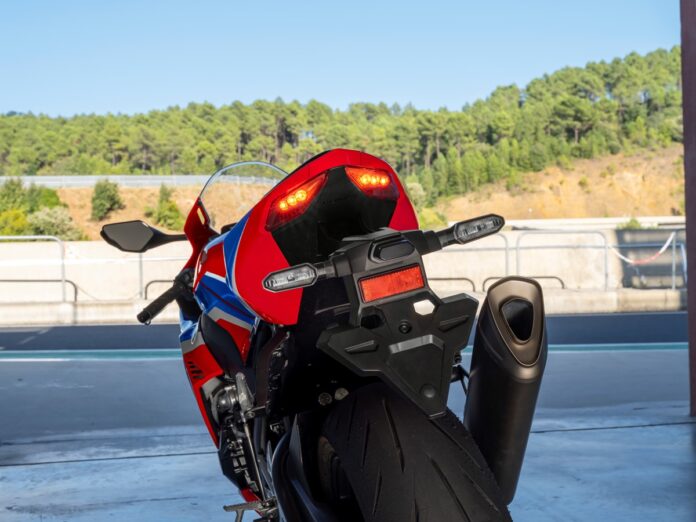
22YM HONDA CBR1000RR-R FIREBLADE
- Technical Specification
| ENGINE | |
| Type | Liquid-cooled 4-stroke 16-valve DOHC Inline-4 |
| Engine Displacement (cm³) | 1000cc |
| No. of Valves per Cylinder | 4 |
| Bore ´ Stroke (mm) | 81mm x 48.5mm |
| Compression Ratio | 13.4:1 |
| Max. Power Output | 160kW @ 14,500rpm |
| Max. Torque | 112Nm @ 12,500rpm |
| Noise Level | Lurban – 74dB, Lwot – 77dB |
| Oil Capacity | 4.0L |
| FUEL SYSTEM | |
| Carburation | PGM-FI |
| Fuel Tank Capacity | 16.1L |
| C02 Emissions WMTC | 153 g/km |
| Fuel Consumption | 15.2km/L (6.6L/100km) |
| ELECTRICAL SYSTEM | |
| Starter | Electric |
| Battery Capacity | 12-6ah YTZ7S |
| DRIVETRAIN | |
| Clutch Type | Wet, multiplate hydraulic clutch |
| Transmission Type | Manual 6-speed |
| Final Drive | Chain |
| FRAME | |
| Type | Aluminium Twin Tube composite twin spar |
| CHASSIS | |
| Dimensions (L x W x H) | 2100 x 745 x 1140mm |
| Wheelbase | 1460mm |
| Caster Angle | 24o |
| Trail | 102mm |
| Seat Height | 830mm |
| Ground Clearance | 115mm |
| Kerb Weight | 201kg |
| SUSPENSION | |
| Type Front | SHOWA BPF 43mm telescopic fork with preload, compression and rebound adjustment, 120mm stroke |
| Type Rear | SHOWA BFRC-Lite Pro-Link swingarm with 10-step preload, stepless compression and rebound damping adjustment, 137mm stroke. |
| WHEELS | |
| Rim Size Front | 17 inch x 3.5 |
| Rim Size Rear | 17 inch x 6.0 |
| Tyres Front | 120/70-ZR17 M/C (58W)
Pirelli Diablo Supercorsa SP Bridgestone RS11 |
| Tyres Rear | 200/55-ZR17 M/C (78W)
Pirelli Diablo Supercorsa SP Bridgestone RS11 |
| BRAKES | |
| ABS System Type | 2 Channel |
| Front | 330mm disc with radial-mount 4-piston Nissin caliper |
| Rear | 220mm disc with 2-piston Brembo caliper |
| INSTRUMENTS & ELECTRICS | |
| Instruments | TFT-LCD |
| Security System | Honda Smart Key |
| Headlight | LED |
| Taillight | LED |
| Auto Winker Cancel | Yes |
| Quickshifter | Optional |
All specifications are provisional and subject to change without notice.
** Please note that the figures provided are results obtained by Honda under standardised testing conditions prescribed by WMTC. Tests are conducted on a rolling road using a standard version of the vehicle with only one rider and no additional optional equipment. Actual fuel consumption may vary depending on how you ride, how you maintain your vehicle, weather, road conditions, tire pressure, installation of accessories, cargo, rider and passenger weight, and other factors.
For more Honda Motorcycles UK news check out our dedicated page Honda Motorcycles UK News
or head to the official Honda Motorcycles UK website honda.co.uk/motorcycles.html








